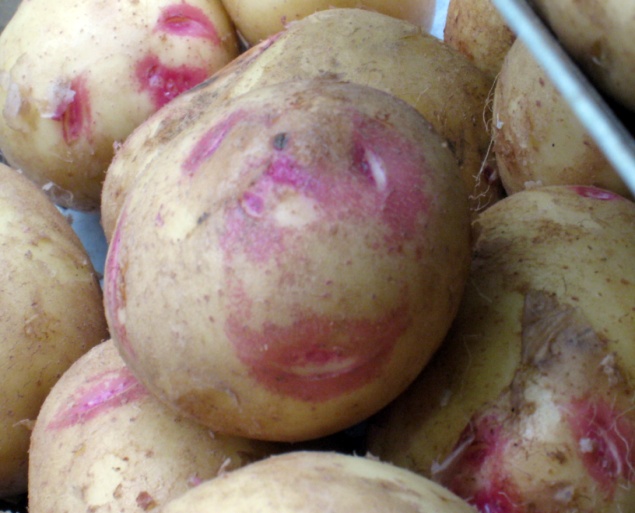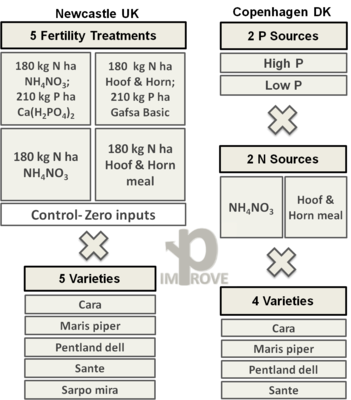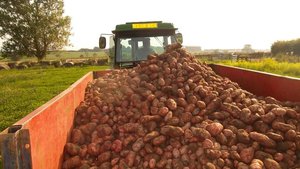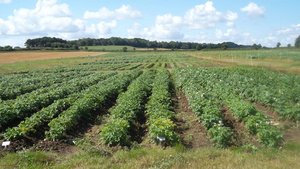Varietal choice improves P use efficiency in IMPROVE-P trials
Agricultural production is dependent on non-renewable sources of P and farmers need to use P inputs as efficiently as possible. Experiments in Denmark and the UK showed that the efficiency of P use in organic potatoes can be improved if late-season varieties with vigorous top and root growth are used.

Soil P deficits can develop if crop exports are not replaced
Organic farming systems rely on the efficient use and recycling of nutrients such as Nitrogen (N), Phosphorous (P) and Potassium (K). However, P balances calculated for organic farms can indicate a P deficit with more P removed in the products than applied as fertilizer, especially for arable farms with low or no animal husbandry.
This leads to decreasing amounts of plant available soil P with a direct effect on yield, as well as limitations on other processes which indirectly impact on yield e.g. symbiotic N2 fixation.
Replacing P exports with allowable sources such as rock P and organic waste products is one strategy, but it can be challenging since these sources often contain P that is not or only partially available for plant uptake.
Challenges managing P in organic potato systems |
Potatoes are particularly inefficient in their use of P. In conventional systems they generally recover <10 % of applied P fertilizer and this figure may be lower in organic systems which rely on less soluble forms of P. Inefficiencies in P recovery by potatoes may be related to their shallow root systems and lack of effective associations with beneficial P mobilizing organisms like mycorrhizal fungi. In organic systems it is important to maximize the recovery and recycling of applied nutrients to ensure that yields are not limited by nutrient supply. For this reason the IMPROVE-P project (https://improve-p.uni-hohenheim.de/) was established to consider a diversity of strategies for addressing P deficiencies in organic farming systems. These include: (a) enhanced P recycling using alternative P fertilizers such as recycling products obtained from the sewer system, treated household or food processing waste, meat and bone meal, wood ash, (b) increased plant P use efficiency through agronomic measures such as the use of efficient varieties, adapted application techniques, and P mobilization by cover cropping, and (c) the application of plant growth promoting rhizobacteria. |
Comparing varieties and input types to improve P efficiency
In 2014 similar experiments were established in the UK (Newcastle University) and Denmark (University of Copenhagen) to study potato varieties with different P-efficiencies in two different growing environments, using long-term trials with gradients in soil P availability.
The objective was to determine if some varieties were more efficient than others at accessing P from the soil and added amendments, and turning it into yield, and whether the same varieties would be effective in two different environments. Potato varieties were selected for testing that had displayed contrasting levels of P efficiency in previous trials within the NUE-CROPS (www.nue-crops.eu) project.
These included:
- Maris Piper, an intermediate to late-maturing variety that is the most popular potato among conventional growers and consumers in the UK
- Cara, a very late-maturing variety that proved high yielding under low input conditions in the NUE-CROPS project (Figure 1)
- Sante, an intermediate maturing variety that can be productive under organic management
- Pentland Dell, an intermediate to late-maturing variety that did not show high efficiency in the NUE-CROPS project
- Sarpo Mira (Newcastle only), a very late-maturing variety with high nutrient use efficiency and blight tolerance
At Copenhagen University the experiments took place in the Crucial long term trial in which past management has resulted in two treatments with varying soil P levels: one with low P (soil available P 13 mg kg-1) and one with high P (soil available P 45 mg kg-1).
At Newcastle University the experiments took place in the "NUE" plots which had been cropped with cereals continuously for the past 7 years. P had not been applied as an amendment to any of these plots for the previous 5 years so that all treatments were in the low P (10-15 mg P kg-1) range in autumn 2013. To remove the effect of N deficiency on potato growth, some of the treatments received supplemental N. This resulted in what is known as a "factorial design" for the experiment where every variety was tested at every level of P and N at both sites (see Figure 2).

Figure 2. Diagram showing the different varietal and fertility treatments
included in the Crucial trial (Denmark) and the NUE trial (UK)
At both sites an organically acceptable N source was tested – Hoof and Horn meal - and compared to conventional ammonium nitrate fertilizer as an N source. At Nafferton, P was also added P as either an organically acceptable source (Gafsa Rock P) or conventional triple super phosphate (TSP), to some of the treatments.
Long-season varieties are most efficient at using P
Both the yield and efficiency of P use were affected by the variety choice and fertilization strategy at both sites. In the UK Cara tended to have the highest total plant biomass (measured at its maximum, see Fig. 3) for all fertility treatments, and this translated into the highest yields for tubers.
For a standard organic treatment in the UK (receiving Hoof and Horn meal and Gafsa) total tuber yields of Cara averaged just over 30 t fresh matter per hectare. This can be contrasted with the inefficient variety Pentland Dell, which yielded less than 20 t fresh matter per hectare for this treatment. The fully conventional treatments yielded dramatically higher, especially for Cara which had a total fresh yield of nearly 40 t per hectare when mineral N and P were provided.
Yields for the Danish trials were much higher than the UK trials with Cara, Maris Piper and Sante all yielding a total of 60-70 t fresh matter per hectare in the high P plots with added Hoof and Horn meal. Even in the low P plots Sante still yielded over 50 t fresh matter per hectare. These high yields were partially attributed to the N supply from Hoof and Horn meal which was applied at a higher rate than the ammonium nitrate in the Danish trials on the assumption that its N would not be fully available in the year of application.
Cara may have done well at both sites because it has exceedingly long haulm (stalks and leaves) longevity, and produces a larger and deeper root system than Sante and Maris Piper. This allows it more time to access P reserves in the soil as well as more time for the plant canopy to intercept sunlight and convert it into plant biomass and ultimately, tuber yields. Thus, there appears to be potential for the selection or breeding of potato genotypes with root systems that exploit the soil volume and acquire P more efficiently in combination with longer canopy life and greater photosynthetic capacity.
Fast N from Hoof and Horn meal and slow P from Gafsa
The different fertility treatments in the experiments allowed some additional questions to be answered. For example, when yields with Hoof and Horn meal were compared to yields for ammonium nitrate only, there were no significant differences in the UK trials, even though equivalent amounts of N were applied and higher yields in Denmark. This demonstrated that Hoof and Horn meal is a readily available source of N for organic farmers, even though its ammonium and nitrate-N content is a very small proportion of its total N content (total N ~15%).
Gafsa rock P was used as a P source in the Newcastle trials. This source is commonly recognized as a slow-release source of P, especially in calcareous soils. Even though the Newcastle soils did not have a high pH (6-7), the P provided by the Gafsa did not appear to be available to the potatoes in the year of application, with no difference in yields recorded between plots that received Hoof and Horn alone, and those that received Hoof and Horn plus Gafsa. This confirms that organic farmers cannot adopt a substitution-based approach to providing P to crops where they simply replace TSP with rock P. Rock P needs to be part of a long-term approach to managing P levels in organically managed soils, and should be used to offset long-term deficits in field and farm-level P budgets.
An integrated strategy for P management in organic potatoes
|
This, combined with a long-term approach to managing soil P that is based on managing field-level balances, should offer a sustainable strategy for P management in organic systems. | |
| P use efficiency was associated with vigorous top-growth as shown by Cara plant harvested when above-ground biomass was at its maximum. |
 |  |
| It has been a busy day at Newcastle University’s Nafferton Farm. | A part of the NUE plots where the experiment at Newcastle took place. Effect of the fertility and the variety on growth is obvious. |
Authors:
Leo Rempelos, Nafferton Ecological Farming Group, Newcastle University
Julia Cooper, Nafferton Ecological Farming Group, Newcastle University
Jakob Magid, Section for Plant and Soil Sciences, University of Copenhagen
Yaosheng Wang, formerly at Section for Plant and Soil Sciences, University of Copenhagen
About Improve-P
Improve-P is a CORE Organic II project, which is coordinated by International Centre for Research in Organic Food Systems, ICROFS.
 This research has demonstrated that there is potential to select potato varieties with vigorous top and root growth and later maturity dates to maximize access and utilization of soil nutrient reserves.
This research has demonstrated that there is potential to select potato varieties with vigorous top and root growth and later maturity dates to maximize access and utilization of soil nutrient reserves.